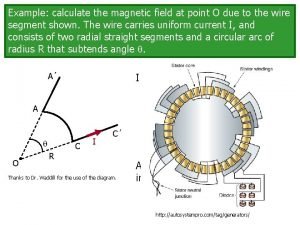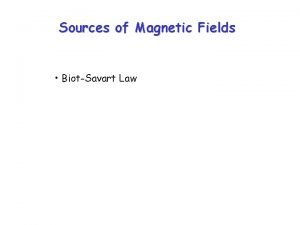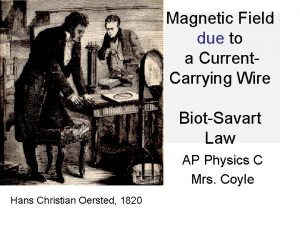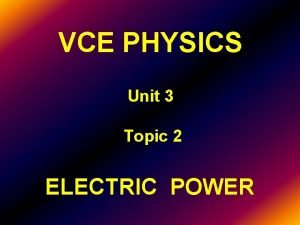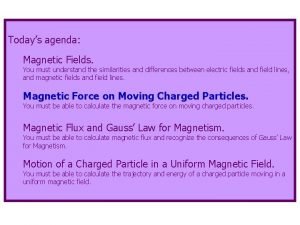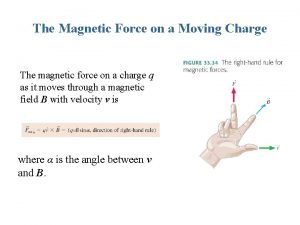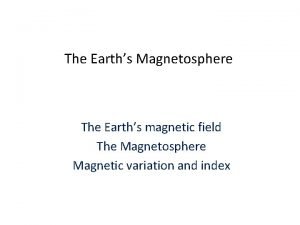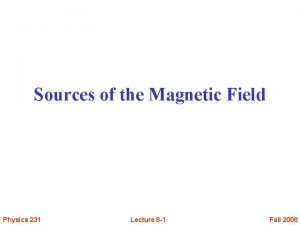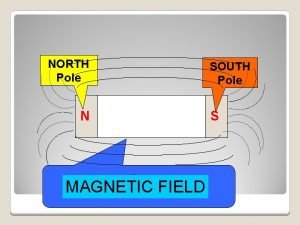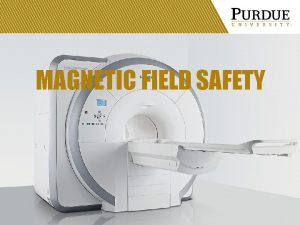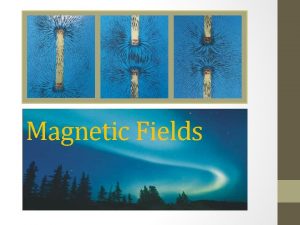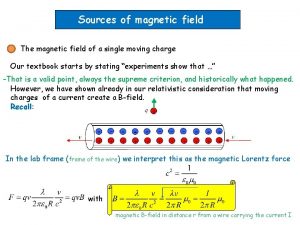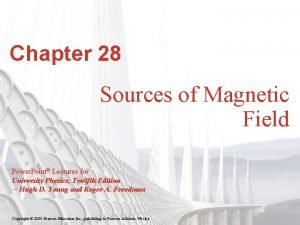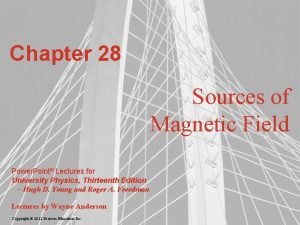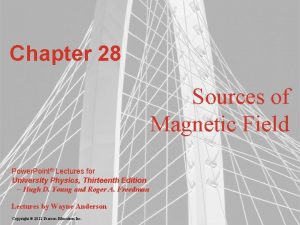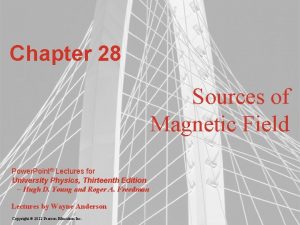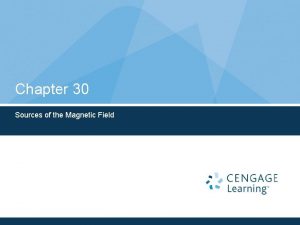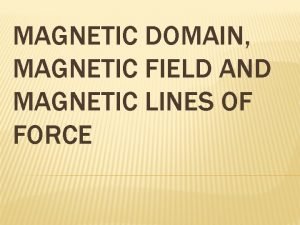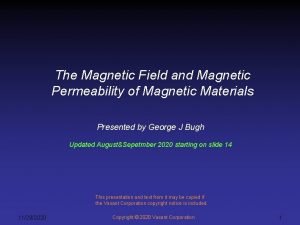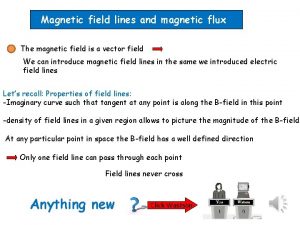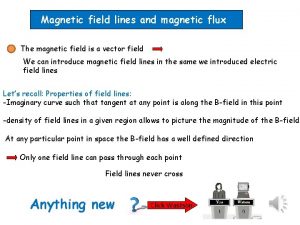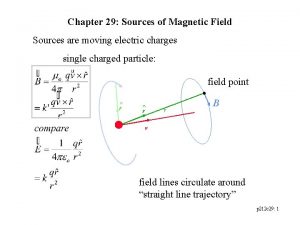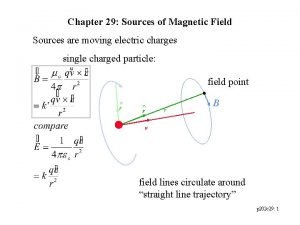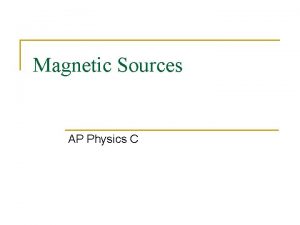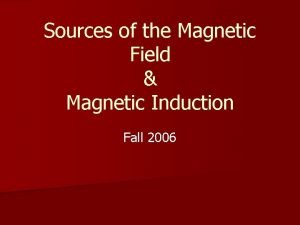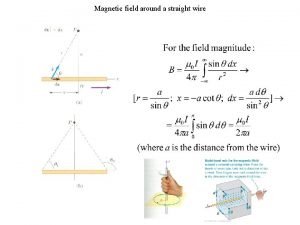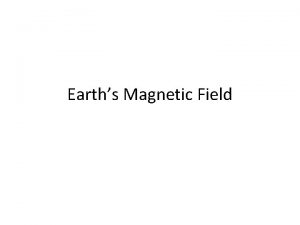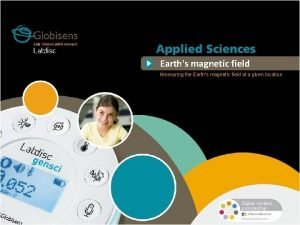Chapter 28 Sources of Magnetic Field Power Point




















- Slides: 20

Chapter 28 Sources of Magnetic Field Power. Point® Lectures for University Physics, Twelfth Edition – Hugh D. Young and Roger A. Freedman Lectures by James Pazun Copyright © 2008 Pearson Education Inc. , publishing as Pearson Addison-Wesley

Goals for Chapter 28 • To study the magnetic field generated by a moving charge • To consider magnetic field of a current-carrying conductor • To examine the magnetic field of a long, straight, current-carrying conductor • To study the magnetic force between currentcarrying conductors • To consider the magnetic field of a current loop • To examine and use Ampere’s Law Copyright © 2008 Pearson Education Inc. , publishing as Pearson Addison-Wesley

Introduction • Normally, when someone describes a solenoid, they are likely to use a doorbell or car-starter as their example. In the photo at right, scientists at CERN are using the most powerful magnetic field ever proposed. Copyright © 2008 Pearson Education Inc. , publishing as Pearson Addison-Wesley

The magnetic field of a moving charge • A moving charge will generate a magnetic field relative to the velocity of the charge. • See Figure 28. 1 at right. Copyright © 2008 Pearson Education Inc. , publishing as Pearson Addison-Wesley

Moving charges—field lines • The moving charge will generate field lines in circles around the charge in planes perpendicular to the line of motion. • Follow Example 28. 1. • Refer to Figure 28. 2. Copyright © 2008 Pearson Education Inc. , publishing as Pearson Addison-Wesley

Magnetic field of a current element • The magnetic field of several moving charges will be the vector sum of each field. • Refer to Figure 28. 3 at right. • Consider Problem-Solving Strategy 28. 1. Copyright © 2008 Pearson Education Inc. , publishing as Pearson Addison-Wesley

Magnetic field of a current element II • Follow Example 28. 2 and Figure 28. 4 below. Copyright © 2008 Pearson Education Inc. , publishing as Pearson Addison-Wesley

Magnetic field of a straight current-carrying conductor • Biot and Savart contributed to finding the magnetic field produced by a single current-carrying conductor. Copyright © 2008 Pearson Education Inc. , publishing as Pearson Addison-Wesley

Fields around single wires • Refer to Example 28. 3. • Refer to Example 28. 4. • Figure 28. 7 illustrates Example 28. 4. • These apply to wires like the one at right in Figure 28. 8. Copyright © 2008 Pearson Education Inc. , publishing as Pearson Addison-Wesley

Forces and parallel conductors • This is a classic demonstration. When you run the current one way through one rod and the other way through the second, they will snap together. If you reverse the connections on one rod so that both currents run the same way, the rods will fly apart. • Follow Example 28. 5. • Figure 28. 9 illustrates this concept. Copyright © 2008 Pearson Education Inc. , publishing as Pearson Addison-Wesley

Magnetic field of a circular current loop • A loop in the x, y plane will experience magnetic attraction or repulsion above and below the loop. Copyright © 2008 Pearson Education Inc. , publishing as Pearson Addison-Wesley

Magnetic fields in coils • Consider Figures 28. 13, 28. 14, and 28. 15 below. • Follow Example 28. 6. Copyright © 2008 Pearson Education Inc. , publishing as Pearson Addison-Wesley

Ampere’s Law I—specific then general Copyright © 2008 Pearson Education Inc. , publishing as Pearson Addison-Wesley

Ampere’s Law II • Consider Figure 28. 18. • Follow Problem-Solving Strategy 28. 2. • Follow Example 28. 7. Copyright © 2008 Pearson Education Inc. , publishing as Pearson Addison-Wesley

Field inside a long cylindrical conductor • A cylinder of radius R carrying a current I. • Refer to Example 28. 8 and Figure 28. 20 and Figure 28. 21. Copyright © 2008 Pearson Education Inc. , publishing as Pearson Addison-Wesley

Field of a solenoid • A helical winding of wire on a cylinder. • Refer to Example 28. 9 and Figures 28. 22– 28. 24. Copyright © 2008 Pearson Education Inc. , publishing as Pearson Addison-Wesley

Field of a toroidal solenoid • A doughnut-shaped solenoid. • Refer to Example 28. 10 and Figure 28. 25. Copyright © 2008 Pearson Education Inc. , publishing as Pearson Addison-Wesley

Magnetic materials • The Bohr magneton will determine how to classify material. Refer to Figure 28. 26 below. Follow Example 28. 11. • Ferromagnetic, paramagnetic, and diamagnetic will help us designate material that’s naturally magnetized or magnetizable, material that can be influenced by a magnetic field, and finally, material that is not interactive with a magnetic field. Table 28. 1 at right will aid any calculation. Copyright © 2008 Pearson Education Inc. , publishing as Pearson Addison-Wesley

Magnetic materials II • Consider Figure 28. 27 at right. • Consider Figure 28. 28 below. Copyright © 2008 Pearson Education Inc. , publishing as Pearson Addison-Wesley

Magnetic materials III • Consider Figure 28. 29 below. • Follow Example 28. 12. Copyright © 2008 Pearson Education Inc. , publishing as Pearson Addison-Wesley
 Magnetic moment and magnetic field relation
Magnetic moment and magnetic field relation Weber flux
Weber flux Magnetic field and magnetic force
Magnetic field and magnetic force 21lwuy8i6hw -site:youtube.com
21lwuy8i6hw -site:youtube.com Electric field and magnetic field difference
Electric field and magnetic field difference Magnetic field
Magnetic field Find the magnetic field at point o
Find the magnetic field at point o Find the magnetic field at point o
Find the magnetic field at point o Magnetic force
Magnetic force Print and web sources
Print and web sources Important of water management
Important of water management Difference between antiferromagnetism and ferrimagnetism
Difference between antiferromagnetism and ferrimagnetism Real power formula
Real power formula Powerbi in powerpoint
Powerbi in powerpoint Point point power
Point point power Right hand palm rule magnetic field
Right hand palm rule magnetic field Magnitude of magnetic force
Magnitude of magnetic force Integral of magnetic field
Integral of magnetic field Magnetometer
Magnetometer Magnetic field inside a conductor
Magnetic field inside a conductor Magnetic field strength
Magnetic field strength






